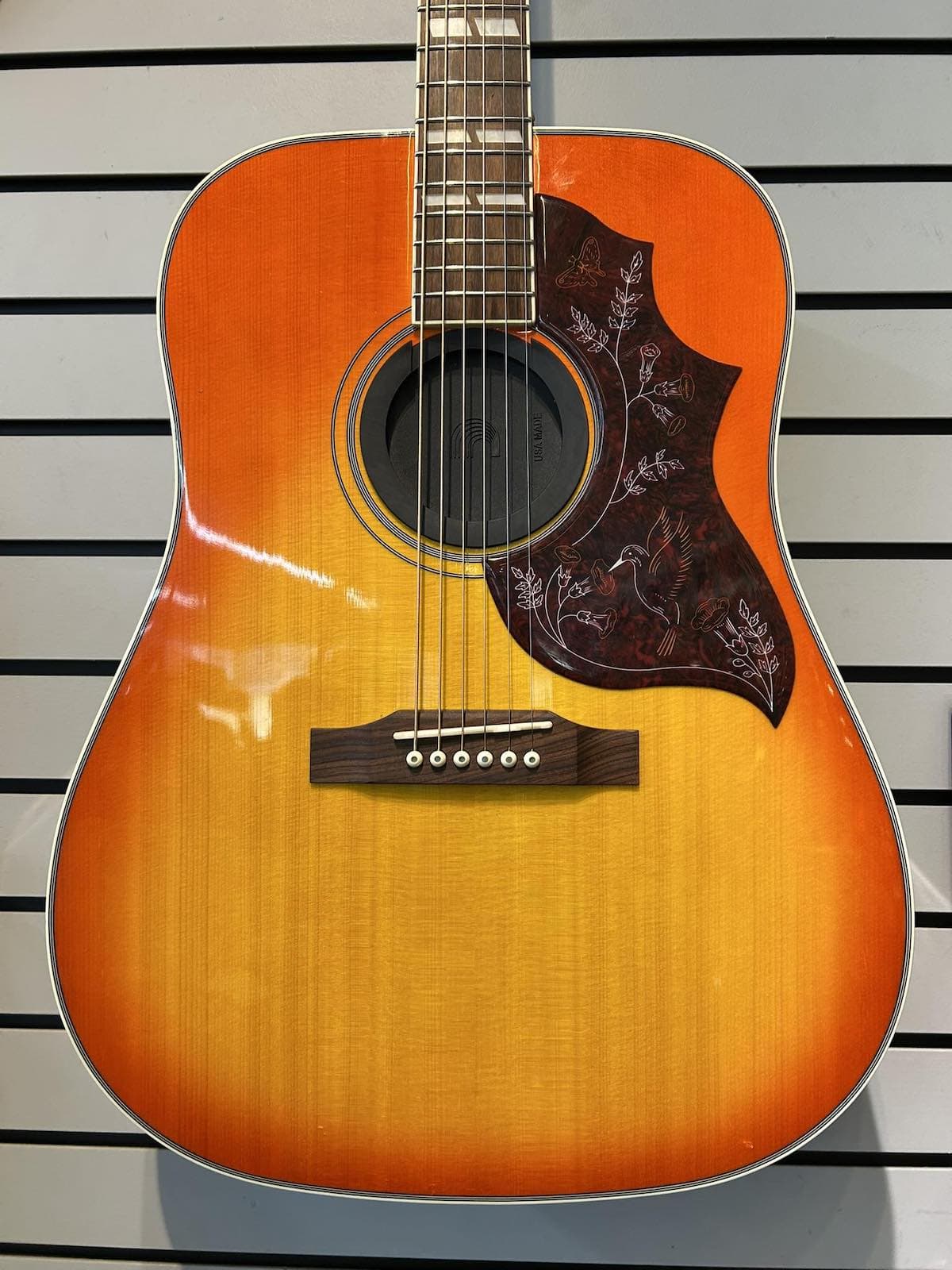I know, it costs a fraction of the original. So, I’m not here to tell you that this is any close to the real Hummingbird. Now that that’s out of the way, this guitar might just be the best budget acoustic guitar out there today.
Beyond its stunning looks (and the aesthetic resemblance to the original), this is a feature-packed instrument in its own right that can match or outdo any competitors. Which, in such an overcrowded niche as budget acoustics, is saying a lot.
So, whether you’re into it because of the looks, the sounds, or the feel, this guitar is a great choice. I played it and took it to the extreme. I’m not going to say everything I found was nice, but this guitar gave me great times to talk about right here.
Quick Take
Loud, great-looking, and surprisingly solid for the price — Epiphone's Hummingbird Studio is more than just a fun couch strummer. It could easily be an intermediate player's workhorse, or a capable backup stage guitar.
The Dreadnought Body
First and foremost, this is a dreadnought-body guitar. That is good and bad news.

Epiphone Hummingbird Studio - Up Close
The dreadnought body, if the guitar isn’t defined and tight in its bottom end, tends to sound boomy and go into muddy territory right away. I know this because before having my all-solid, all-mahogany Martin, I had my fair share of budget acoustics.
The Hummingbird isn’t the exception. On the contrary, I tried playing some fingerpicked bluesy licks that require abuse from the sixth string to get the percussive thing going, and the result was muddy, unclear, and, frankly, not cool. That said, it’s very hard to get a good fingerpicking sound out of any guitar this big.
We, fingerpickers and slide blues players, swear by parlor and small acoustics. We’ll get to the solid spruce top in a few paragraphs, but it really helps definition when things get too thick.
Playing chords is a whole different deal with this guitar. I know, we’ve all seen those badass pictures of Keith and Mick posing with those gorgeous Gibsons while writing Exile on Main St. So, I just had to play some righteous Rolling Stones songs. For that, I did the open-G trick and tuned the guitar to D-G-D-G-B-D.
Songs like “Tumbling Dice” and “Jumpin’ Jack Flash” only sound like the original when you tune it to open G.
The big con was the low D. It made the guitar choke on its own low end, sounding a little unbalanced.
The good news, on the other hand, is that this is one loud guitar. I’m telling you, everybody heard me within 65 feet of distance. It’s loud and proud with great projection, especially in the midrange. It doesn’t do the J-200 thing, but it holds perfectly unplugged for a solo gig.
Speaking of which, I played it at a solo gig as a backup for my Martin for a few songs. The guitar held up to my needs and proved it can fill the room with great acoustic tones when pushed with the picking hand.
Plus, isn’t it the ultimate stage-ready acoustic to play those shows? I mean, the Martin looks amazing, but you can’t beat the look of a Hummingbird; definitely a neck-turner.
So, the laminated mahogany dreadnought body isn’t as defined and tight as to avoid getting muddy. That said, when driven hard, it becomes twice its size and can fill any room.
The Neck & The Fingerboard
Let me start by saying that I agree with you 100%. Epiphone should apply several layers of moisture to the creamy-looking Pau Ferro fingerboard. It’s so unappealing upon picking up the guitar that it might even be a deal-breaker for many.
That said, the feel of Pau Ferro is close to that of rosewood. I’m talking mostly about aesthetics. While it’s true that the warm sweetness of rosewood is uncanny, Pau Ferro tends to have an added snap that works great with the guitar’s mahogany neck and body.
Again, fighting back the boominess is always welcome when playing a laminated-mahogany dreadnought guitar.
The neck is a slim-taper with a sweet and sexy D-shape that’s just buttery to play. One thing to bear in mind here is that it features a 24” scale. This helps reduce string tension. While many might argue it doesn’t help with tuning stability, it feels effortless to play. Bends are just delicious.
The radius is 12” of pure and friendly real estate to play big chords and leads with the same ease. Also, I’m not a big guy with Jimi-like huge hands. On the contrary, I’m on the other end of that spectrum, and my hands just fell at home with this guitar.
I don’t usually like the glossy finish on guitar necks because it feels sticky and obtrusive when playing fast. Especially a neck this slim and inviting. Well, the good news is that, although this guitar is sprayed with thick poly paint, it feels smooth to the hand.
The medium jumbo frets, the binding on the entire neck, and the Grover tuners look pretty and dependable. From what I could see with just my eyes, the finish was perfect not only on the body but also on the neck.
It’s just a little lemon oil on the fretboard, Epiphone people. I know you can make it happen.
The Solid Spruce Top
In my opinion, the one thing that makes this guitar stand out and cut through in such a tight competition is that it has a solid soundboard with proper X-bracing. This is not a minor detail and is what separates the world of acoustic guitars.
I mean, those of us who slowly climbed that ladder from laminated to solid can tell the difference, and it’s a huge one. It makes a guitar sound enormous and vibrate organically rather than having zero sustain and sounding dull and brittle.
For a guitar this size, and made with laminated mahogany, you need something solid in the midrange to make it sing and cut through. Well, using solid Sitka spruce in this price range for the top is a game-changer if you ask me.
My way of testing is very simple, and it works like a charm. I learned this when I worked in a music store.
I pick up the guitar and form a major chord. Any chord. Then, I start with my fingers, arpeggiating it. Avoiding any pauses, I start strumming gently. Still not stopping, I move to the pick and increase the strength of the strumming. Finally, I use an up-and-down strumming pattern and give the guitar all I have.
If the top is solid, the guitar will sound louder as you strum harder. The more energy you give the top to make it vibrate, the bigger and better it sounds. Although a guitar that’s all solid ends up being a huge resonance box projecting tight lows, powerful mids, and musical highs, this guitar did a great job. The bottom-end isn’t as tight or defined, and neither are the mids. But it’s organic and sounds great throughout the spectrum.
Believe me, strumming Oasis classics, I had to double-check the price tag.
If you’re a beginner or a hobbyist, you don’t need to spend beyond this guitar. For pro live and studio musicians, and those with a refined ear, the guitar might be too boomy and undefined.
The Fishman Preamp
I usually play all-acoustic gigs with my Martin and the Baby Taylor (my travel tales with it). One guitar in standard tuning and another in open G. Yeah, I know. It scares me a lot, too, to play that kind of show because there’s nowhere to hide. Well, partly that’s why I do it, because of the adrenaline. Isn’t that why we all go on stage? To feel music more intensely while it performs its miracle.
Well, this one gig, I broke the second string on my Martin by song three. It was a shared bill, and I ended up playing an Epiphone Hummingbird Studio, courtesy of the next band’s guitarist.

Playing my Martin D15M live.
At first, I thought the same, I always think about the Fishman PreSys (the preamp installed in the Baby Taylor, btw); it’s just too thin. It doesn’t do any justice to the generous bottom end of this guitar.
On one hand, it gets rid of all muddiness when playing live, and you never have that low rumble you sometimes get with acoustics this size on small stages.
On the other hand, especially when playing a solo show, you lack that warmth dreadnought guitars ooze all the time.
So, while playability-wise I didn’t miss my guitar, something was lacking in the bottom end. While I heard it boomy and huge acoustically, the projected tone was rather midrange-oriented.
Again, nothing you can’t solve by swapping it out for a different piezo system or with an EQ or even an IR pedal.
What happened that night was that a pro photographer was hired. Oh yes, I kept and used those photos a lot. I mean, this guitar begs to be photographed, and you look so cool playing it, it almost feels like you played better than you did.
So, unplugged, and comfort-wise, this guitar is an outstanding bang-for-the-buck. While the plugged sound is good enough for most occasional live players, pro guitarists will find it lacking.
My Verdict
Nothing beats the Hummingbird in terms of looks. Furthermore, compared to the price of a Gibson Hummingbird or even an Epiphone Inspired by Gibson Hummingbird, this guitar is a complete steal.
I say this because, beyond the looks, which alone might be a reason for purchase, this is a good guitar. It’s a good couch guitar, a great beginner instrument, a fantastic choice for hobbyists, and, since it has a solid top, it will surely age quite well, too.
For a more refined ear, the pro musician or the seasoned session player, this guitar is not comparable to an elite-level instrument. That said, it’s a great, affordable backup, a nice stage guitar (swapping the electronics), and a nice on-the-road tool.
Final Word
Loud, great-looking, and surprisingly solid for the price — Epiphone's Hummingbird Studio is more than just a fun couch strummer. It could easily be an intermediate player's workhorse, or a capable backup stage guitar.
Happy humming, I mean… playing!

